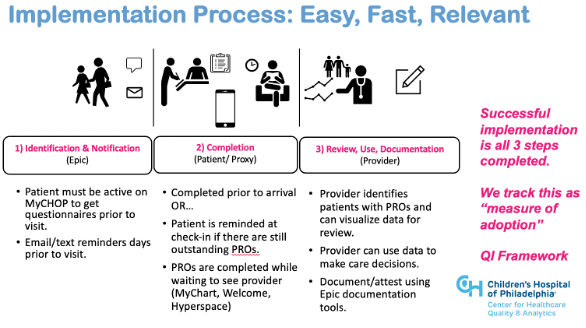Quality Improvement/Patient Safety: All Areas
QI 5: Quality Measures, Family Centered & Inpatient QI
240 - Lessons learned from large scale implementation of patient reported outcome measures
Publication Number: 240.451
.jpg)
Daria Ferro, MD (she/her/hers)
Attending Physician
Childrens Hospital of Philadelphia
Philadelphia, Pennsylvania, United States
Presenting Author(s)
Background: Patient-reported outcome (PRO) measures can describe a patient’s health and health-related quality of life from their perspective (or via a proxy when a patient is unable to report themselves). At a patient-level, PROs can offer clinicians new insights, inform clinical decision-making, and ultimately lead to higher quality, patient-centered care. At a system level, PROs can guide individual program and organization wide improvement efforts and be used secondarily for research. However, studies and reports have demonstrated consistent challenges to local and system-wide implementations.
Objective:
To design and operationalize a program for facilitating and spreading the collection and use of PROs in clinical care delivery
Design/Methods:
We formed a centralized program at a large, tertiary care children’s hospital to support adoption, measurement, interpretation, and improve PROs for primary use in delivery of clinical care and quality improvement. We applied learnings from peer-reviewed literature and other health systems’ experiences, and through iterative cycles, developed a clear, sustainable process (methodology and infrastructure) for PRO implementation. This includes a standardized set of implementation metrics, electronic health record tools, and data and analytics reporting dashboards. The team is led by a Physician Clinical Informaticist and includes an Improvement Advisor (i.e., project management and quality improvement expertise), a data analyst, an Information Services specialist (Epic).
Results:
Over 44,000 pediatric outpatient subspecialty visits have had PRO measures incorporated into medical decision making for over 25,000 patients using our electronic health record (EHR)’s tools. Implementations are monitored using implementation metrics dashboard (Figure 1). Individual implementations are monitored from 3 lenses represented conceptually in Figure 2. Clinical sites can compare implementation metrics across locations. Balancing metrics, such as patient-centered question burden, and race, ethnicity, and language preference filters, allow for data-driven design decisions and future PDSA-cycle planning. Implementation metrics are linked to outcome metrics where available.
Conclusion(s):
IIterative cycling, emphasized in quality improvement and clinical informatics, has been generally well accepted and is feasible for small teams across a range of clinical specialties in implementing PROs. Describing PROs as “prescribed” for patient care can be a powerful way to quickly establish a shared mental model around expectations for patients, families, and clinical team members..png)

